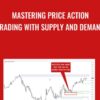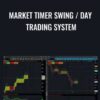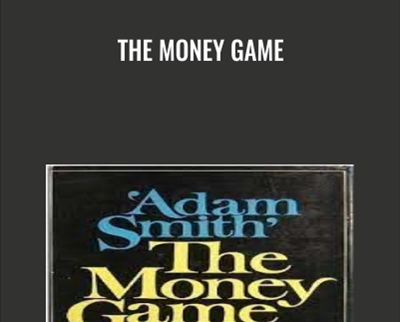$37.00
The Money Game is a series of stories on the games people play with money and markets. Told by Adam Smith (aka George Goodman), the stories uncover the emotion, error, myth, and irrationality that surrounds it all.
 Purchase this course you will earn 37 Points worth of $3.70
Purchase this course you will earn 37 Points worth of $3.70Elevate your skills with the The Money Game – Adam Smith course, available for just $37.00 on Utralist.com! Browse our curated selection of over 60,000 downloadable digital courses across diverse Uncategorized. Benefit from expert-led, self-paced instruction and save over 80%. Start learning smarter today!
The Money Game is a series of stories on the games people play with money and markets. Told by Adam Smith (aka George Goodman), the stories uncover the emotion, error, myth, and irrationality that surrounds it all.
The Notes
- Keynes was one of the first to describe the markets as a game, one that is “intolerably boring and over-exacting to anyone who is entirely exempt from the gambling instinct; while he who has it must pay to this propensity the appropriate toll.”
- The game can be defined several ways: 1) something done as sport or fun; a diversion of sorts to keep things interesting, or 2) something more along the lines game theory, through math and weighing probabilities to decide on the most likely outcome.
- The market — investing — is the greatest game of all. Because investing is “an exercise in mass psychology, in trying to guess better than the crowd how the crowd will behave.”
- The goal of the game is to make money, but for some, the goal is only about playing the game. (Of course, in order to play the game, you have to play in a way so that you always stay in the game.)
- “It has taken me years to unlearn everything I was taught, and I probably haven’t succeeded yet. I cite this only because most of what has been written about the market tells you the way it ought to be, and the successful investors I know do not hold to the way it ought to be, they simply go with what is.”
- Ask a dozen people the value of a stock and you’ll get a dozen answers. It’s best to view stock valuation as a range, instead of a fixed price. The factors that give a stock a value and price come partially from the financial statement, and mostly from the mood of the market.
- The mood is what makes a system, a theory, a strategy, or a rational view on markets imperfect, imprecise, sometimes wrong, and irrational. Mood makes markets biological, complex, and in a constant state of change.
- You have to know yourself. You have to be observant and honest and learn from mistakes. The decisions made around investing paint a portrait of who we are — biases and all. It’s better to figure it out, learn from it, and use it to our advantage, then to ignore it, fight against it, and fail.
- Irregular Rule #1: “If you don’t know who you are, this is an expensive place to find out.”
- Emotional maturity, remaining calm, keeping your cool, discipline, and patience are all used to describe a way of being in highly emotional, stressful, or anxiety filled situations. In other words, the markets. Succumbing to the stress and anxiety is why investing is so costly.
- “…the real test is how you behave when the crowd is roaring the other way.”
- “The crowd always loses because the crowd is always wrong. It is wrong because it behaves normally.” — Fred Kelly, Why You Win or Lose: The Psychology of Speculation, 1930
- Everyone believes themselves to be a contrarian when really their part of the crowd. Also, human nature suggests most people find comfort being part of the crowd.
- Every bubble or euphoric period — from tulips to South Seas shares to Nifty Fifty to Dotcom stocks — must start with a rational idea. As the story spreads, the crowd mentality takes over, till it eventually peaks. Then every dip lower becomes a false buying opportunity.
- “Crowds are somewhat like the sphinx of ancient fable: it is necessary to arrive at a solution of the problems offered by their psychology or to resign ourselves to being devoured by them.” — Gustave Le Bon, The Crowd: A Study of the Popular Mind, 1896
- Why do they play the game? For many different reasons: the action, the image it presents, the sense of belonging (being in a crowd), being on the “inside”, the stories to brag to friends and strangers, basically, so they can say they play the game.
- And few people actually play for the money.
- All the participants play the game differently. They make up their own set of rules and have a different definition of winning. And they often change the rules and the definition multiple times depending on how well they’re playing.
- Greed and fear are the strongest emotions in the market. Nobody likes to watch others make more than them. And we hate losing more than like winning.
- Those two emotions (along with others) have a huge impact on an investors willingness to change goals and time horizons. Hesitant, cautious, and timid at the bottom. Bold, confident, and audacious at the top. The exact opposite of what’s necessary for success.
- “No matter what role the investor has started with, in a climax on one side or the other the role melts into the crowd role of greed or fear. The only real protection against all the vagaries of identity-playing, and against the final role of being part of the crowd when it stampedes, is to have an identity so firm it is not influenced by all the brouhaha in the marketplace.”
- “…the end object of investment is serenity, and serenity can only be achieved by the avoidance of anxiety, and to avoid anxiety you have to know who you are and what you’re doing.”
- Irregular Rule #2: “The identity of the investor and that of the investing action must be coldly separate.”
- Any sense of attachment or emotion to an investment can lead to a humbling experience for the most brilliant investors.
- “The most important thing to realize is simplistic: The stock doesn’t know you own it .” Nor does it care. Investing is the epitome of a one-sided relationship. Emotional connections don’t exist.
- Detachment means you can change your mind or reverse course, without being tied down by prior decisions.
- Beware of goals identified by numbers because it’s easy to fixate on a big round number and sometimes the goals — goalposts — often get moved by jealousy or envy or greed…or dreams. How many investors, despite big gains, hold on for “just a little more” and never got there. In the book, that’s the story of Harry, who could be anybody. He fixated on $1,000,000 because that was a life-changing number. He came close so many times, and took big risks (margin) to get there, but failed because anything less wasn’t enough.
- “Nothing works all the time and in all kinds of markets… If you really love playing the Game, any action is better than inaction, and sometimes inaction is the proper course, if it has been taken after measuring all the measurable options. If a decision is made not to make a decision, that is just as much a decision as a decision which initiates action.”
- The trouble with high growth companies: they carry the seeds of their destruction. Unless the company has some advantage, the high growth attracts copycats. Growth is spread across competitors, prices get cut as they battle for market share, and profit margins suffer. And when that doesn’t work, there’s a point where growth falters because growth is finite. Companies grow too big to grow at a high rate and there’s no magic number that says when they hit too big. And then there’s the market. There’s no way to know the multiple the market would put on the growth.
- Adam Smith’s bias — Concentration: “Sweet are the uses of diversity, but only if you want to end up in the middle of an average. By concentrate I mean in a few issues only. There are, at any one moment, only a few stocks that have a maximum potential, and I, for one, am not smart enough to be able to follow more than a handful of stocks at a time… If you are concentrated in only a few stocks, you are forced to measure each of them in terms of potential against each new idea that comes along, and this in turn makes you bump the bottom stocks off — the worst-performing ones — to take aboard something more promising.”
- Irregular Rule #3: “Find smart people.” Phil Fisher, the creator of the scuttlebutt approach, looked at his past successes to find that only one-sixth of them were found through scuttlebutt. The five-sixth, the rest, were from a network of smart people he knew and trusted. The downside: groupthink.
- “When there is no skepticism, there is almost no one left to sell to.”
- Many people choose to play the game as described by Keynes’s beauty contest: “We have reached the third degree where we devote our intelligences to anticipating what average opinion expects the average opinion to be.” So all kinds of systems have sprung up to figure out what is everybody else doing? Really, they’re finding out, what has everybody else done but never solving, what will everybody else do.
- But why what is everybody else doing? Because it’s comfortable. If you’re doing what you believe everyone else is doing, you’re making money when they make money, losing when they’re losing, and risking about the same as everyone else. Doing the opposite of everybody else is often an uncomfortable place to be.
- If those systems, actually worked — could always predict what everybody else was doing — everyone would use it, and it would stop working.
- Instead, if enough people follow a system, it becomes a sort of self-fulfilling prophecy…for a while. So if the system buys what goes up, then what is going up will continue to go up. — “Once it is accepted that the patterns can represent motion, it follows that a Trend is a Trend is a Trend until it stops being a Trend.”
- “Past patterns help determine future patterns; momentum can be shown on the charts.”
- Emotion is the last bastion that no one has figured out how to measure: “No one has yet learned how to put emotions into serial correlation coefficients and analyses of runs. It is absolutely true that statistically the price of a stock has no relation tomorrow to what it was yesterday. But people — the Crowd — do have a memory that extends from day to day.”
- “Meanwhile — not that it means anything — there are few rich random walkers, and few rich Chartists. But there are some quite successful investors around who have no particular system. Perhaps they are the lucky holders of serial runs, perhaps they are more rational or have better access to information, and perhaps — something not taken into account in the austere statistical worlds — they are better students of psychology.”
- An overreliance on mathematics imbues an expectation of precision in markets that are rarely precise. The more complex the math, the more speculative the results.
- Accounting standards and financial statements imply precision too, yet earnings can be manipulated up or down any number of ways. Example: there is no uniformity between companies on depreciation charges, amortization, inventory valuation, or goodwill. The implication: using complex math and “manipulated” financial statements to unearth things like precise earnings or growth trends is impossible. Investing is more art than science, so treat it as such.
- The truth is almost every investor, broker, analyst takes the accounting numbers at face value and rarely spends/has the time to look past the image management wants to project to see what’s being manipulated, why, and what it really means.
- “If the profit numbers on income statements are treated with such reverence, it was obviously only a question of time before some smart fellows would start building companies not around the logical progression of a business but around what would beef up the numbers. Such a corporation is called a “conglomerate” or a “free-form” company, very popular when the market gets to tulip-time.”
- The quote above refers to the conglomerate craze of the ’60s — see ITT and TLV — that used acquisitions to show earnings growth and accounting trickery to hide the real losses.
- There has always been a They in markets, which Smith refers to as elephants, that move markets at a whim.
- On the Depression: “It is a sobering experience to read through—as once I did—all the Wall Street Journals and Barron’s from 1929 to 1933. Quarterly, reports came out saying, ‘the outlook is favorable,’ ‘a sustained recovery is on its way,’ and so on. But nobody was listening. Those on margin had been sold out in 1929 and 1930. But from 1930 to 1933, a real blight of the spirit took place.” From 1929 to 1933, the Dow fell almost 90%. The Depression described the economy and the mood at the time. Much like what Smith describes, the book Oh Yeah!, published in 1932, relays a lot of the forced optimism from CEOs and the government who repeated said a recovering was right around the corner.
- Liquidity, or lack thereof, is the biggest threat to short-term performance chasers. If everyone wants to get out, and no one is buying, losses pile up fast.
- The risk to funds managers includes optics: how does it look to own big losers, how does it look to own winners, how does it look sitting on a big pile of cash while the market rises. It’s career risk. Not many are willing to bet their jobs by looking wrong or dumb in the short term, even if looking wrong produces great results in the long term.
- “The market does not follow logic, it follows some mysterious tides of mass psychology.”
- The mass psychology has a way of taking hold of every new generation of investors because they’re too young to remember to any bad times and they’re undefeated in the current market. So they fall in love with “the New Math, the New Economics, and the New Market.”
- “The most brilliant and perceptive analysis you can do may sit there until someone else believes it too, for the object of the game is not to own some stock, like a faithful dog, which you have chosen, but to get to the piece of paper ahead of the crowd. Value is not only inherent in the stock; to do you any good, it has to be value that is appreciated by others… If you are in the right thing at the wrong time, you may be right but have a long wait; at least you are better off than coming late to the party. You don’t want to be on the dance floor when the music stops.”
- The end-of-the-worlders, doomsayers, and gold-bugs have existed in markets forever and their calls will never cease.
- “Markets are only a tiny facet of society, but being made by mass psychology, they are a good litmus paper for what is going on. Markets only work when they believe, and this confidence is based on the idea that men can manage their affairs rationally. The longest period of prosperity in the last few hundred years came when everyone believed that the king was on the throne, that the pound was worth a pound, that God was in His Heaven, and that all these things would continue for ever and ever… In the longer run, the actions of all the investors, individual and institutional, professional and nonprofessional, have to be based on the belief that leadership knows what it is doing and that rational men are handling the nation’s business rationally. If that belief fades, then so do the markets. They do not merely dive, they dive and then they disappear. It happened here in the blight of the spirit from 1930 to 1933, and it has happened in other countries.”
- Money is how the game is scored…a path to being rich. The conundrum lies in how you define rich. You can treat it as a possession to see who can collect the most or you treat it as a means to an end, the means being financial freedom and enjoyment of life.
Get The Money Game – Adam Smith , Only Price $37
Tag: The Money Game – Adam Smith Review. The Money Game – Adam Smith download. The Money Game – Adam Smith discount.
Cultivate continuous growth with the The Money Game – Adam Smith course at Utralist.com! Unlock lifetime access to premium digital content, meticulously designed for both career advancement and personal enrichment.
- Lifetime Access: Enjoy limitless access to your purchased courses.
- Exceptional Value: Benefit from savings up to 80% on high-quality courses.
- Secure Transactions: Your payments are always safe and protected.
- Practical Application: Gain real-world skills applicable to your goals.
- Instant Accessibility: Begin your learning journey immediately after buying.
- Device Compatible: Access your courses seamlessly on any device.
Transform your potential with Utralist.com!
Related products
Uncategorized
= 95 Points
= 85 Points
Uncategorized
Proven Fall Prevention Strategies: Exercise, Meds Management and Home Modification – Trent Brown
= 40 Points
Uncategorized
= 30 Points
= 84 Points
Uncategorized
Legal Risks in Nursing Documentation – Use Extreme Caution When Skimming the Facts – Rosale Lobo
= 40 Points
= 125 Points
Uncategorized
Cognitive Rehabilitation Therapy: Practical Interventions and Personalized Planning – Jane Yakel
= 85 Points





